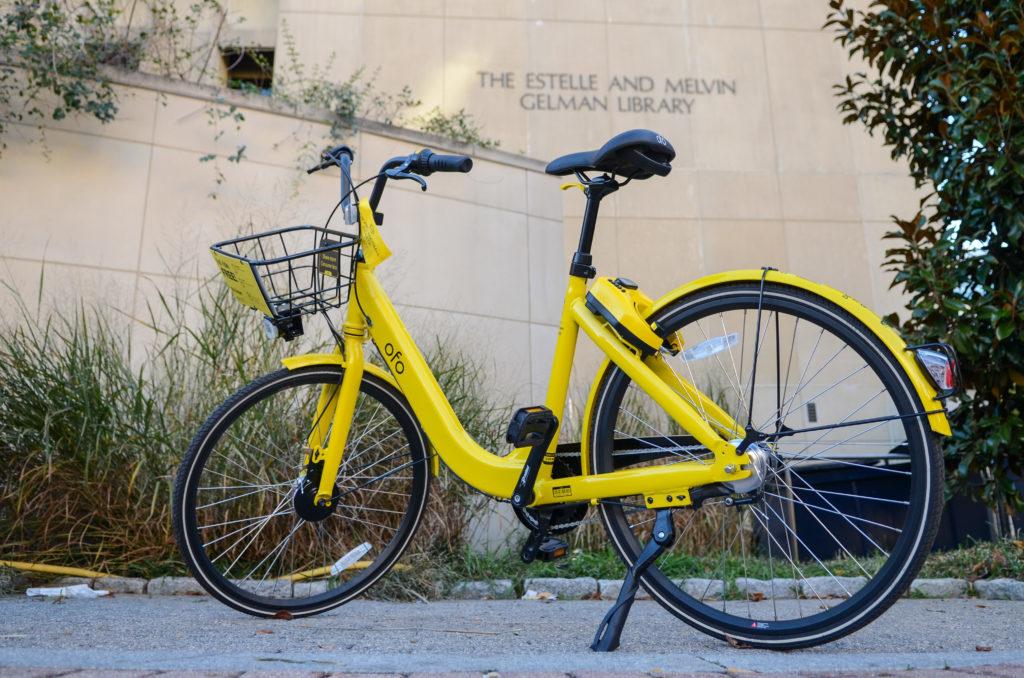Neighbors have found colorful bikes strewn out on the sidewalks over the past two months, and critics say the new “dockless” bike program is an inconvenience at best and a hazard at worst.
Five dockless bike-sharing companies – which run services allowing bikes to be parked anywhere in the city without having to dock at a pre-established station – have launched temporary programs in the District since September as part of the District Department of Transportation’s efforts to increase bike-ability in the District. Since the companies have come to the Foggy Bottom Campus, several residents said the bikes make it more convenient and affordable to travel in the city, but some said bikes left sitting along sidewalks pose a serious safety threat to pedestrians.
DDOT decided to explore the dockless bicycle model to expand the number of shareable bikes in the city and allow bikes into parts of the District that don’t have city-run Capital Bikeshare stations. Dockless bikes allow users to unlock a bike using an app and drop it off anywhere.
The plan will last until April 2018 and then will be reevaluated to see if it will become permanent. Since the pilot program was implemented last month, the colorful bikes from various providers have become fixtures across the neighborhood.
Under the companies’ agreements with users, bikes must be left in “appropriate parking places” like the curb of a sidewalk. Unauthorized parking spaces include the White House and Capitol complexes, the National Mall and private property, The Washington Post reported last month.
William Kennedy Smith, a commissioner of the Foggy Bottom and West End Advisory Neighborhood Commission, said he is planning a town hall in the coming weeks at the School Without Walls at Francis Stevens for neighbors to air concerns about the bikes.
Smith said he’s heard concerns about the bikes limiting space for pedestrians to walk and getting left in inappropriate places. He said he wants to learn more about how the companies manage the number of bikes in an area and who would be held responsible for an illegally parked bike – the company or the user.
“Obviously this is a pilot, so we want to get as much input as we can about people’s experience with these and see if we can formulate some constructive feedback for DDOT based on what’s been going on the last couple of weeks,” he said.
Through the program, dockless bikesharing companies including LimeBike, Mobike, Spin, JUMP and Ofo have placed and managed their bikes in neighborhoods throughout the city, including in Foggy Bottom.
Maura Danehey, a DDOT spokeswoman, said users have largely “respected the District’s public space.” To mitigate overcrowding of bikes, each of the five companies is allowed to put a maximum of 400 bikes out on the streets, she said.
“DDOT is conducting regular oversight of the operators to address problems proactively and as they arise in specific locations,” Danehey said in an email.
Nelle Pierson, the director of external affairs for JUMP D.C., one of the dockless bike companies, said to avoid unsafe bike parking, JUMP bikes have an integrated lock designed to secure the bikes to designated places, like bike racks and street signs.
Mary Caroline Pruitt, a spokeswoman for LimeBike, said the company has a feature on the app that allows users to report if bikes are irresponsibly parked, out of service or require maintenance.
“In D.C. and in all our cities, LimeBike’s on-the-ground, local operations team is constantly monitoring the bikes to ensure they are distributed properly,” she said in an email.
But several neighbors say they are upset that bikes have been left across the city in odd and sometimes dangerous places.
Christina Farnsworth, a resident living on the corner of H and 24th streets, said she encountered a bike in the middle of the sidewalk in front of 7-Eleven and later saw another resident trip over the bike. She said the anew system doesn’t allow users who use the bikes irresponsibly to be held accountable.
“You can’t leave a car in the middle of an intersection,” she said. “You’d get a ticket in no time, but if it was to be ticketed, who would be ticketed?”
David Alexander, a member of the D.C. Bicycle Advisory Council for Ward 2, which advocates for increased bike use in the District, said it is useful to know where permanent bike docks are located around the District and that using an app to chase down a bike at an unknown location is less efficient and dangerous.
“Many bikes are placed without regard to pedestrian traffic, in the pedestrian’s way, where it’s inconvenient for non-handicapped people and could be calamitous for people who are physically or visually handicapped,” he said.
University spokeswoman Maralee Csellar said the University was not involved in conversations to bring the bikes to campus, since the bikes should be parked on city-owned sidewalks.
“We would like to encourage our GW community members who may be using this program to be mindful of where they leave these bikes after use,” she said in an email. “Please do not leave them in the walking areas of the sidewalk, building entrances or major campus thoroughfares.”





